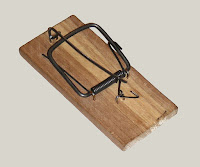What is a Mousetrap Car:
“A small vehicle having its only source of motive power to be a mousetrap” (Mousetrap Car, Wikipedia)
 |
An example of a mousetrap car
|
How a Mousetrap Car Works:
A mousetrap car doesn’t need batteries or fuel. It is powered by simply setting the trap and letting it loose. The wound spring has a ton of potential energy stored in it. The power from the spring propels the car. A rod, or lever, (typically used to snap the neck of a mouse), pulls the string wound around an axle. The string unwinds, converting the potential energy from the wound spring into kinetic energy; causing the wheels to rotate, pushing the mousetrap forward. This process basically converts the energy from the spring into rotational energy which is delivered into the wheels to make the car move.
On a frictionless surface, the car would move forever, however, since there is friction. In order to overcome the friction, the car, or anything for that matter, has to work harder. “Friction converts energy into heat and sound which removes energy from your motion, causing the vehicle to roll to a stop as its energy is removed.” (Mousetrap Cars, 2004)
How fast or how far it moves is dependent upon the design of the car and the materials used. The longer changes the pulling force applied to the drive axle; the longer the lever the more string
from the drive axle. This means. Basically, the longer the lever the farther it goes. With a shorter leer, more force is delivered to the drive axle, making it faster. The lever controls how fast
 |
| Long Lever |
the car is and how far it goes. The length of the lever also effects the torque that is applied to the wheels. (According to "What is Torque," torque is "a measure of how much a force acting on an object causes that object to rotate.") The diameter of the spindle also effects the torque. The larger the spindle the larger the torque.
The drive wheels of the car also play a factor on how fast and far a car will go. The bigger the wheels of the car are; the farther it goes, but with lesser force. The larger wheels go farther per rotation than smaller wheels. However, a larger wheel means less force. This is because as the wheel gets bigger, the amount of torque needed required to start the car and keep the car going is greater. "For long distance mousetrap racers a large diameter drive wheel with a small diameter drive axle is desired. For speed trap racers a smaller diameter drive wheel with a larger diameter drive axle is desired." (Balmer 2012). In order for the car to move, the drive wheels must have traction, otherwise the car would spin out. (According to the Mirriam-Webster dictionary, traction is "the force that causes a moving thing to stick against the surface it is moving along or the power that is used to pull something.")
"Mechanical advantage is the ratio of output force to input force which is a tradeoff between distance moved and the amount of force....With the mechanical advantage working in the opposite direction moving a short distance with more force results in less force in the output but moving a larger distance. " (Mousetrap Cars, IdeasInspire) Mechanical advantage trades force for distance. (So a little force for a big distance=a big force for a little distance.) "In the mousetrap car drive axle the small circumference spun by the string wrapped around it for a relatively short length propels the much larger drive wheels a much greater distance but with a smaller amount of force. This is why the car must roll with little friction." (Mousetrap Cars, IdeasInspire)
James Henry Atkinson and The Little Nipper
James Henry Atkinson, a British inventor, invented a prototype mouse trap in 1897. He named it the "Little Nipper," a classic snapping mouse trap. The Little Nipper has a, "small flat wooden base, the spring trap, and wire fastenings...
[and] slams shut in 38,000s of a second and that record has never been beaten." (Bellis). Even today, this trap has been used. According to Bellis, this type of mouse trap has captured 60% of the British mouse trap market, "an estimated equal share of the international market." Atkinson sold the patent for The Little Nipper for 1,000 pounds to a Welsh company named Procter in 1913.
However, since then, Austin Kness thought of a humane mouse trap, without the use of bait, catching
 |
| Mouse trap similar to the Little Nipper |
Why Mousetrap Cars are Useful:
"1. Real World Applications: The linear motion of mouse trap cars closely resembles that of actual automobiles. By analyzing the data obtained from mouse trap cars, students will understand how automobiles obtain and maintain speed. Also, they will have an idea on how distances relate to time. More importantly, they will understand how the slope of a distance versus time graph represents the velocity of their car.
2. Career Connections: The linear motion of automobiles is a large topic in mechanical engineering. Also, car mechanics need an understanding of the relationship between distance and time.
3. Societal Impact: The general society has taken a vast appreciation of automobiles in the last century. As a person of this society, we need a fast and efficient way to travel. By understanding the relationship between distance and time, students will better understand the impact of automobiles on our daily life. Whether that means calculating gas mileage or simply how long it will take to make a trip." (Mousetrap Mania)
example of a working mousetrap car
Sources:
Images/Videos:



It was really insightful.
ReplyDeleteThanks for such a nice content.
Cheers
BTW if anyone interested more have a look batterymodeon.com thanks